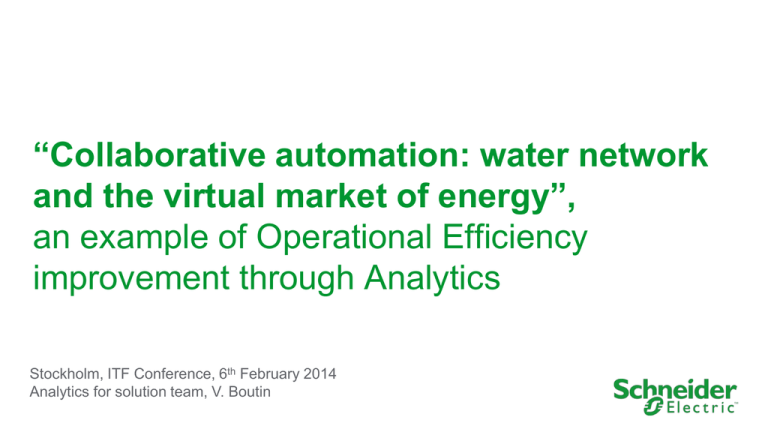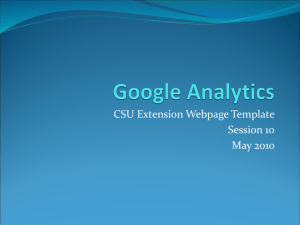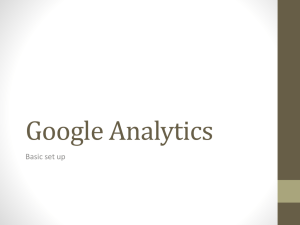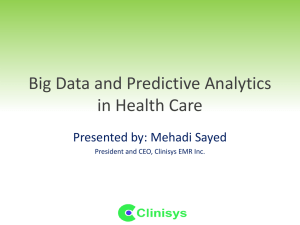5_Conference ITF-Automation 2014
advertisement

“Collaborative automation: water network and the virtual market of energy”, an example of Operational Efficiency improvement through Analytics Stockholm, ITF Conference, 6th February 2014 Analytics for solution team, V. Boutin Schneider Electric at a glance Customers are looking for integrated solutions that make their lives easier while optimizing costs. Innovation is essential to satisfying those requirements. The convergence of automation, information, and communication technology has created dramatic new opportunities for advancing energy efficiency. Innovation is about combining these opportunities with smart services to deliver high-value yet easy-to-deploy solutions. Pascal Brosset, SVP Innovation, Schneider Electric 24 billion € sales in 2012 41% of sales in new economies 140 000+ people in 100+ countries 4-5% of sales devoted to R&D X2 Increase of the volume of data every two years 1 Billion Collective volume of data points being generated by Smart meters in the US every day Digitization and Analytics bring new opportunities to improve Operational Efficiency 17 b$ Estimated total revenue for big data by 2015 (IDC) Beyond basic KPIs Opportunity to extract value out of collected data Cloud Big data storage and analysis across various information inputs Analytics 3.0 In the new era, big data will power consumer products and services. by Thomas H. Davenport What are Analytics ? Value for Customers ……………………………What best can happen?............................ Optimization Predictive ………..……..What will happen next?............................. Modelling …….…What if trends continue?......................... Forecasting Statistical …..Why is this happening?...................... Analysis Notification ..………What Alerts Query …………..What Drilldown Ad Hoc ……………..How Reports Standard ……………What Reports action is needed?..................................... is the cause of the problem? ……………………. many? How often? Where?............................................. happened? ……………....…………………………………………. Degree of Intelligence 7 Analytic features for Operational Efficiency to create new information such as prevision, patterns, early detection of problems Data correlation & prediction Context dependent control to take better actions regarding organization, planning and control to provide rationale for building an optimized design and development strategy for the future Decision support through simulation Data Disagreggation & information discovery Resources & activities planning and scheduling Performance evaluation & benchmarking Condition monitoring, diagnostic, maintenance Virtual or smart sensors Get advanced information (such as fermentation for beer micro-filtration, or milk powder hulidity…) by collecting and mixing several correlated data items Early detection of abnormalities Few concrete examples Extract early signals that would detect abnormal behaviours and possibly link to performance degradations Demand response for water distribution Determine the best srategy for pumping, while ensuring that the water demand will be entirely met, and leveraging variable energy prices (modulation market) Technologies to make it happen Better control, supervision, operation management, design and continuous improvement Analytics to INTERACT Analytics to OPTIMIZE Analytics to SIMULATE Analytics technologies Physical models Analytics to MODEL Dynamic system modeling Pattern learning Data from Visual analytics Pattern discovery Low cost Self powered Communicating Easy to install Pervasive sensors Energy sensor Comfort sensor Enable collaborative automation by networked embedded devices Infrastructure for data collection and integration with heterogeneous applications and legacy systems An example in more details: Collaborative automation between water networks and virtual energy market 4 Energy cost is a challenge for water distribution companies Water networks offer good opportunities for virtual energy market Water is easier to store than electricity and water utilities can turn it into cash Technical enablers are necessary Decision making tool ensuring that the water demand will be entirely fulfilled, evaluating the economic equation, and providing the best strategy to maximize benefits Control system A typical use case example Automatic calculation of modulation capabilities for 24 coming hours Based on: Previsional pumping plan Water demand and operational constraints Energy prices dynamic context What-if scenarios and decision For each potential modulation, the water network manager can: Preview the pumping scheduling, tanks storage and pressure levels Select the modulation offers to be sent to aggregator Transaction with aggegator When the energy demand resource will be required, the updated pumping plan will be sent to operation system Main technical bricks On the water network side Water hydraulic simulation (Aquis simulation) Water demand forecast Modulation capabilities calculation (Artelys optimization) Coming from aggregator Transaction module Energy prices Technical point of view Arrowhead technology for bricks interoperability Water demonstration was based on a simulated environment Extracted from the distribution network of Birkerod (small town in Denmark) 10 to 15% cost savings expectations for the demo case Results and Take away Hypothesis: intraday capacity market contract For other cases, benefits will greatly depend on water network characteristics and energy market More generally, some key success factors for new features based on analytics: Technical infrastructures for easy data sharing Services for interoperability between heterogeneous bricks Good interfaces, understanding and interaction with people And an evidence not to forget: the final added value! To contact us Veronique.boutin@schneider-electric.com Alexandre.marie@artelys.com Denis.genon-catalot@lcis.grenoble-inptf.fr Thank you for your attention








